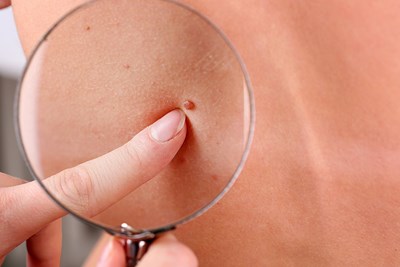Birthmarks, as the name indicates, are present from birth or shortly after. They affect a large quantity of the population, and some tend to fade as you age. While most are innocuous, some can portend the presence of particular illnesses. Others can be unsightly and damage your self-esteem. Here’s a look at when to consider birthmark removal.
If Your Birthmark is Psychologically Damaging
Birthmarks don’t ask you where you’d like them, and some of them can be quite large. Port wine birthmarks, for example, appear commonly on the face and can take up quite a large amount of surface area. While they may not be shy about their appearance, they can make you feel uncomfortable. If your birthmark is large or obvious enough that it’s causing psychological repercussions -- whether that means you’re self-conscious about your appearance or embarrassed enough by it that you don’t leave the house or make friends, it might be time to look into removal.
The most common treatment for port wine birthmarks is laser therapy. This particular therapy will make the mark lighter and potentially even smaller. It may not disappear altogether, but it may go away sufficiently to ease your feelings about it or at least make it easier to cover up. If you can’t stand having an obvious birthmark anymore, talk to your dermatologist about their recommendations for removal. Remember, in many cosmetic cases, insurance is unlikely to pay for a medical procedure. You might try home remedies initially, but these are often not very effective.
If Your Birthmark is Posing a Health Risk
Vascular birthmarks (like port wine stains) are those that appear not because of changes in skin pigmentation, but because of the blood vessels. For example, salmon patches (also called stork bites and angel kisses) appear because of capillaries near the top of the skin. Hemangiomas, however, are more like small, blood tumors. And these can be a problem. Strawberry hemangiomas are smaller, bright red spots. But depending on where they are located they can create additional issues. For example, a baby with a strawberry hemangioma near the mouth may have issues with feeding, while those near other orifices can be problematic in other ways. Furthermore, one near the eyes can inhibit vision and one on the throat may interfere with breathing. On the other hand, hemangiomas also have the potential to become ulcerated, meaning they turn into open sores. If the birthmark is somewhere you don’t use frequently, it may not be an issue (and will likely fade within ten years); but it may be if it’s on the hands or other areas where there is frequent use or friction. If your baby has a strawberry hemangioma somewhere that’s getting in the way of normal functioning, talk to his pediatrician about your options.
Certain moles can pose problems as well. While congenital nevi increase the potential for skin cancer as an adult, some moles can eventually become cancerous. If you have noticed growth or change in a mole that’s been consistent for a long time, you might want to talk to a dermatologist. They can tell you if you need a biopsy, or if you should just get the mole removed to be on the safe side. Keep an eye on any birthmarks or later appearing marks that may be problematic -- and don’t be afraid to talk to your doctor about any marks that make you uneasy.



